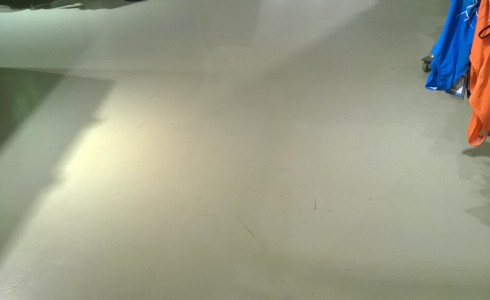DESCRIPTION AND FIELDS OF APPLICATION
Water-based, two-component epoxy self-levelling system for protecting indoor concrete floors subject to pedestrian and wheeled vehicle traffic.
MAIN FEATURES
Water-based system that can be easily used indoors; its viscosity allows self-levelling use; matte/satin finish with good mechanical and chemical resistance. End of pot-life is immediately noticeable, avoiding the use of unsuitable product. Reaches maximum strength upon completion of curing, approx. 8 to 10 days after application under normal conditions.
APPLICATION DATA
The substrate must be clean, free of substances that hinder the adhesion of the system (waxes, silicones, oily traces), compact and very important dry. The presence of water in the pavement, without appropriate preliminary treatment, can cause the coating to detach.
New cementitious substrates must be cured for an adequate time to bring the residual moisture <2% and in any case not less than 40 days. Smooth surfaces must be suitably roughened by mechanical intervention (shot peening, abrasion, etc.), or by applying DUALENE EPX MS (see technical data sheet); previous coatings must always be sanded first, checking in any case the adhesion of the product in place. Tile substrates must be preliminarily roughened and/or etched with MONOPOL PL 06 (see technical data sheet), left on until completely dry and thoroughly rinsing the treated surfaces, then proceed with the application of DUALENE EPX FL (see technical data sheet), and within 24 h (at 20°C), spread the self-levelling system. Base product and hardener should be mechanically mixed for a few minutes before use.
The catalyzed system can be used with different methods depending on the required finish. Decorative effects (foot traffic only). Free of filler in self-levelling systems including multi-colored, pour the mixture help spreading with a trowel, then resurface with bubble breaker roller. Textured trowel with added quartz 006-015/01-03 (size determines final appearance), up to max. 1 kg per 1 kg of catalyzed system diluted 6% with water (120-150 ml/2 kg mix, do not exceed in dilution so as not to diminish system properties).
Pour the loaded mixture onto the substrate and spread it using a metal trowel, shaving the surface; apply a second coat when the previous one is dry, in any case within 24 h at 22°C. Consider whether to sand the layers to remove any ridges; if so, always provide for vacuuming of dusty residues. All decorative effects must be protected with at least 2 coats of DUALENE AIC TRA SW protective paint (see data sheet).
Loaded self-levelling coatings (pedestrian traffic-light traffic/medium wheeled vehicles). For thicknesses up to 2 mm, add quartz 01-03 in quantities ranging from 0.6÷0.8 kg per 1 kg of catalyzed system.
For thicknesses up to 2.5 mm, add quartz 01-05 in quantities varying between 0.8÷1 kg per 1 kg of catalyzed system. The filled system should be diluted with water before pouring to allow self-leveling, between 5-8% (with low temperatures get max. 10%); do not exceed with dilution so as not to decrease the properties of the system.
In cold season keep the two components in heated room before mixing, to facilitate self-leveling, the amount of filler can be slightly decreased. Spread the charged and thinned mixture, tipping it onto the substrate while helping the spreading with a spatula, then go over the surface with a bubble breaker roller.
To work on surfaces already coated with fresh product, use metal crampons. The system has a rapid “out-of-dust” transition, this could cause the coating to be considered walkable after a few hours with obvious risk of altering the surface that has not yet cured; wait at least 36 h under normal conditions before operation.
Operate in the absence of dust or other pollutants that could remain embedded in the fresh layer. To decrease dirt pick-up and facilitate cleaning, apply at least 2 coats of DUALENE AIC TRA SW protective varnish (see data sheet). When overcoating between coats and any protective topcoats, operate within 24 h at 22°C to avoid compromising adhesion.
Operate at temperatures between 15-30°C, including of the substrate (at T below 10°C, catalysis is not complete), and with R.H. < 80%. For the final layer, use product from the same batch to avoid possible slight color differences. Wash tools with water or ethyl alcohol immediately after use.
YIELD
Yield varies depending on the type of substrate being coated, its roughness and the type of finish. Decorative effect with unfilled system: 2.1 kg/m2/mm Textural trowel 0.6÷0.7 2.1 kg/m2 per layer (corresponding to 0.4÷0.5 kg of epoxy system) Filled system 0.6÷0.8 kg quartz 01-03 per 1 kg of catalyzed mixture, 2.1 kg/m2/mm (corresponding to 1.3 kg of epoxy system) Filled system 0.8÷1 kg quartz 01-05 per 1 kg catalyzed mixture, 2.4 2.1 kg/m2/mm (corresponding to 1.2 kg epoxy system) To evaluate yields more accurately according to thickness and substrate roughness, carry out tests beforehand.
TECHNICAL DATA
(mixture) Catalysis ratio Ind./P Base 00/21
Density .36 kg/L (Values 20 days at 25°C system/quartz ratio 1/0.6)
Shore hardness D (7 days) 80
Pot life (125 g at 25°C) 30-40 min.
Hardening at 22°C
- to touch 3 h
- complete 8 days
- Walkability min. 24/36 h with caution
Abrasion resistance (UNI EN ISO 7784-2 – CS 10 – 1 kg) 1000 rpm<100 mg
Min. storage temperature (fears frost) > 5°C
Stability in original packaging 2 months


